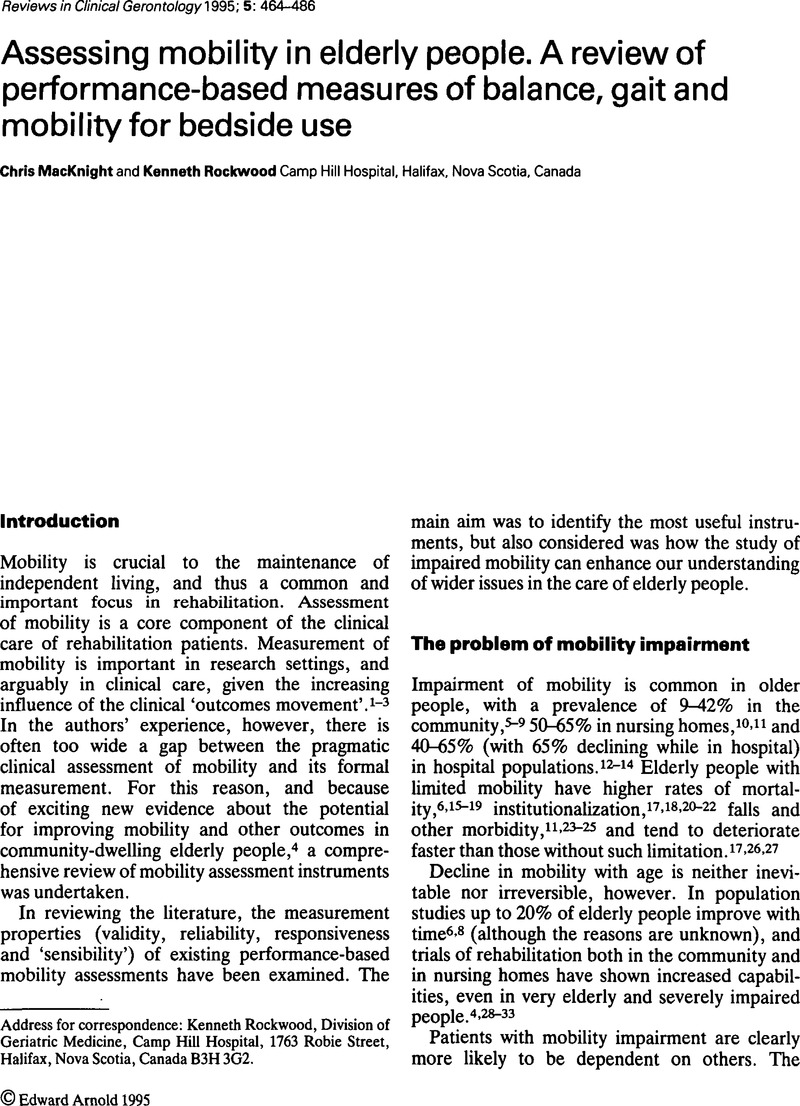Crossref Citations
This article has been cited by the following publications. This list is generated based on data provided by Crossref.
Powell, C
1997.
Frailty: Help or Hindrance?.
Journal of the Royal Society of Medicine,
Vol. 90,
Issue. 32_suppl,
p.
23.
Woo, Jeanne
Ho, Suzanne C.
and
Yu, Ashley L. M.
1999.
Walking Speed and Stride Length Predicts 36 Months Dependency, Mortality, and Institutionalization in Chinese Aged 70 And Older.
Journal of the American Geriatrics Society,
Vol. 47,
Issue. 10,
p.
1257.
Rockwood, Kenneth
Hogan, David B.
and
MacKnight, Chris
2000.
Conceptualisation and Measurement of Frailty in Elderly People.
Drugs & Aging,
Vol. 17,
Issue. 4,
p.
295.
MacKnight, Chris
and
Rockwood, Kenneth
2000.
Rasch analysis of the hierarchical assessment of balance and mobility (HABAM).
Journal of Clinical Epidemiology,
Vol. 53,
Issue. 12,
p.
1242.
Downton, Joanna
2002.
A Textbook of Audiological Medicine.
p.
831.
Robitaille, Yvonne
Laforest, Sophie
Fournier, Michel
Gauvin, Lise
Parisien, Manon
Corriveau, Hélène
Trickey, Francine
and
Damestoy, Nicole
2005.
Moving Forward in Fall Prevention: An Intervention to Improve Balance Among Older Adults in Real-World Settings.
American Journal of Public Health,
Vol. 95,
Issue. 11,
p.
2049.
Tousignant, M.
Boissy, P.
Corriveau, H.
and
Moffet, H.
2006.
In home telerehabilitation for older adults after discharge from an acute hospital or rehabilitation unit: A proof-of-concept study and costs estimation.
Disability and Rehabilitation: Assistive Technology,
Vol. 1,
Issue. 4,
p.
209.
Ganz, Sandy B.
and
Eenkhoorn, L.
2006.
Fysiotherapeutische casuïstiek.
p.
209.
Filiatrault, Johanne
Gauvin, Lise
Richard, Lucie
Robitaille, Yvonne
Laforest, Sophie
Fournier, Michel
and
Corriveau, Hélène
2008.
Impact of a Multifaceted Community-Based Falls Prevention Program on Balance-Related Psychologic Factors.
Archives of Physical Medicine and Rehabilitation,
Vol. 89,
Issue. 10,
p.
1948.
Mokkink, Lidwine B.
Terwee, Caroline B.
Stratford, Paul W.
Alonso, Jordi
Patrick, Donald L.
Riphagen, Ingrid
Knol, Dirk L.
Bouter, Lex M.
and
de Vet, Henrica C. W.
2009.
Evaluation of the methodological quality of systematic reviews of health status measurement instruments.
Quality of Life Research,
Vol. 18,
Issue. 3,
p.
313.
Young, John
2010.
Brocklehurst's Textbook of Geriatric Medicine and Gerontology.
p.
1.
Robitaille, Yvonne
Fournier, Michel
Laforest, Sophie
Gauvin, Lise
Filiatrault, Johanne
and
Corriveau, Hélène
2012.
Effect of a Fall Prevention Program on Balance Maintenance Using a Quasi-experimental Design in Real-World Settings.
Journal of Aging and Health,
Vol. 24,
Issue. 5,
p.
827.
Isaksson, Mats
Johansson, Lars
Olofsson, Ingrid
and
Eurenius, Eva
2013.
Shoulder pain and concomitant hand oedema among stroke patients with pronounced arm paresis.
European Journal of Physiotherapy,
Vol. 15,
Issue. 4,
p.
208.
Uhm, Kyeong Eun
Oh-Park, Mooyeon
Kim, Yoon-Sook
Park, Jae-Min
Choi, Jaekyung
Moon, Yeonsil
Han, Seol-Heui
Hwang, Jeong Hae
Lee, Kun Sei
and
Lee, Jongmin
2020.
Applicability of the 48/6 Model of Care as a Health Screening Tool, and its Association with Mobility in Community-Dwelling Older Adults.
Journal of Korean Medical Science,
Vol. 35,
Issue. 7,



